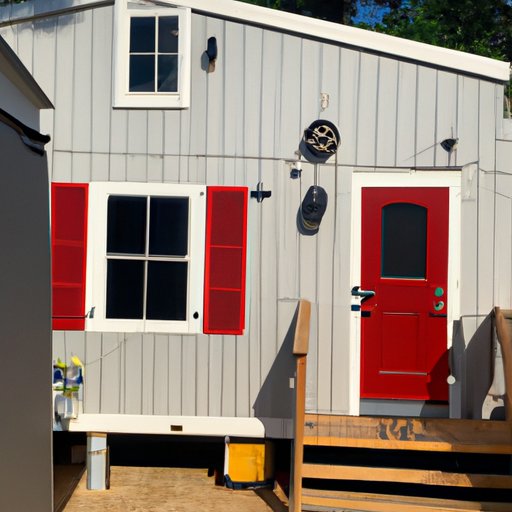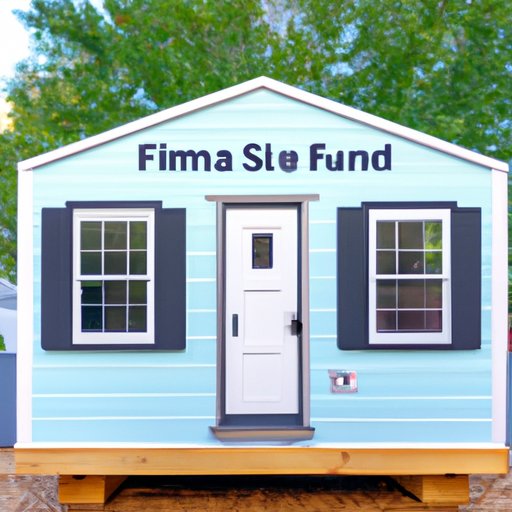Introduction
Tiny homes have become increasingly popular in recent years, providing an affordable and sustainable housing option for those looking to downsize or enter the housing market. But while the upfront cost of a tiny home may be lower than that of a traditional home, purchasing one can still require a significant financial investment. That’s why many people turn to financing when it comes to buying a tiny home.
In this article, we’ll explore the different financing options available for tiny homes, as well as what to consider when making your decision. We’ll also provide some tips on finding the best financing deal for your tiny home, and compare the various rates and terms associated with each type of loan.

Definition of a Tiny Home
A tiny home is a small residence, typically ranging from 100 to 400 square feet in size. It is designed to be both energy-efficient and eco-friendly, utilizing renewable materials such as bamboo and recycled wood in its construction. Tiny homes are usually built on trailers, allowing them to be moved easily and quickly.
The benefits of tiny homes include their affordability, minimal maintenance requirements, and mobility. They offer a great way to save money and live a more sustainable lifestyle, without sacrificing comfort or style.
Benefits of Financing a Tiny Home
Financing a tiny home can be beneficial for several reasons. First of all, it allows you to spread out the cost of your purchase over time, making it easier to manage your budget. It also gives you the opportunity to build up your credit score, as long as you make your payments on time and in full.
Additionally, financing a tiny home can give you access to better deals and incentives. For example, some lenders may offer special discounts or promotions for first-time buyers, or those with excellent credit scores. This can help you get the best deal possible on your tiny home.
Exploring Different Financing Options for Tiny Homes
When it comes to financing a tiny home, there are several different options available. Here’s a look at three of the most common:
Banks and Credit Unions
Banks and credit unions are a popular choice for financing a tiny home. These institutions typically offer competitive interest rates and flexible repayment terms. Many also have special loan programs specifically designed for tiny homes. The downside is that they may require a higher credit score and/or a larger down payment than other lenders.
Government Programs
The government offers various loan programs that can be used to finance a tiny home. These include the Federal Housing Administration (FHA) loan program, which provides low-interest loans for qualified borrowers, and the Department of Agriculture’s Rural Development Loan Program, which offers no-down-payment loans for rural areas. While these programs have certain restrictions, they can be a great way to get a good deal on your tiny home.
Online Lenders
Online lenders are another option for financing a tiny home. These lenders often offer competitive rates and flexible repayment terms, and may not require as much paperwork as traditional lenders. However, it’s important to do your research and read the fine print before signing up for any online loan, as some lenders may have hidden fees or other unfavorable terms.

What to Consider When Financing a Tiny Home
When exploring financing options for a tiny home, there are several factors to keep in mind. Here are a few of the most important ones:
Budget
Before applying for any type of loan, it’s important to determine how much you can afford to spend on your tiny home. Consider the total cost of the home, including taxes, fees, and other expenses. Once you’ve established a budget, you can start looking for lenders who offer loans within your price range.
Credit Score
Your credit score will play a big role in determining the terms of your loan. The higher your score, the more likely you are to qualify for a loan with favorable terms. If your credit score isn’t where you want it to be, take steps to improve it before applying for a loan.
Down Payment
Many lenders require a down payment when financing a tiny home. Generally speaking, the larger your down payment, the better terms you’ll be able to get on your loan. Make sure you have enough saved up for a down payment before you start shopping for a lender.
Tips for Finding the Best Financing Deal for Your Tiny Home
Once you’ve identified the type of loan you’re interested in, there are a few things you can do to ensure you get the best possible deal on your tiny home. Here are a few tips to keep in mind:
Shop Around
Don’t settle for the first loan offer you receive. Take the time to compare rates and terms from multiple lenders to make sure you’re getting the best deal possible. Doing so can help you save money in the long run.
Negotiate Terms
Once you’ve found a lender you’re interested in working with, don’t be afraid to negotiate the terms of your loan. Most banks and other lenders are willing to work with borrowers to come up with a payment plan that works for both parties.
Look for Special Offers
Some lenders may offer special deals and promotions for first-time buyers or those with excellent credit scores. Be sure to ask about any special offers that may be available when you’re shopping around for a loan.

Comparing Tiny Home Financing Rates and Terms
When comparing financing options for a tiny home, there are several factors to consider. Here’s a look at some of the most important ones:
Different Loan Types
The type of loan you choose will affect the interest rate and other terms of your loan. For instance, an FHA loan may have a lower interest rate than a conventional loan, but it may also require a higher down payment. Make sure you understand the differences between the various loan types before making your decision.
Interest Rates
Interest rates are one of the most important factors to consider when comparing loans. Generally speaking, the lower the interest rate, the less you’ll pay in the long run. Be sure to compare the interest rates offered by different lenders to find the best deal.
Fees and Other Charges
In addition to interest rates, make sure you understand any fees or other charges associated with the loan. Some lenders may charge origination fees, closing costs, or other fees, so be sure to read the fine print and ask questions before signing any agreement.
Conclusion
Financing a tiny home can be a great way to enter the housing market or downsize without breaking the bank. However, it’s important to understand the different financing options available and what to consider when selecting the best deal. By shopping around and negotiating terms, you can find the loan that’s right for you and your budget.
We hope this article has helped you learn more about financing a tiny home. For more information on this topic, check out our other resources, such as our guide to tiny home financing.
(Note: Is this article not meeting your expectations? Do you have knowledge or insights to share? Unlock new opportunities and expand your reach by joining our authors team. Click Registration to join us and share your expertise with our readers.)
